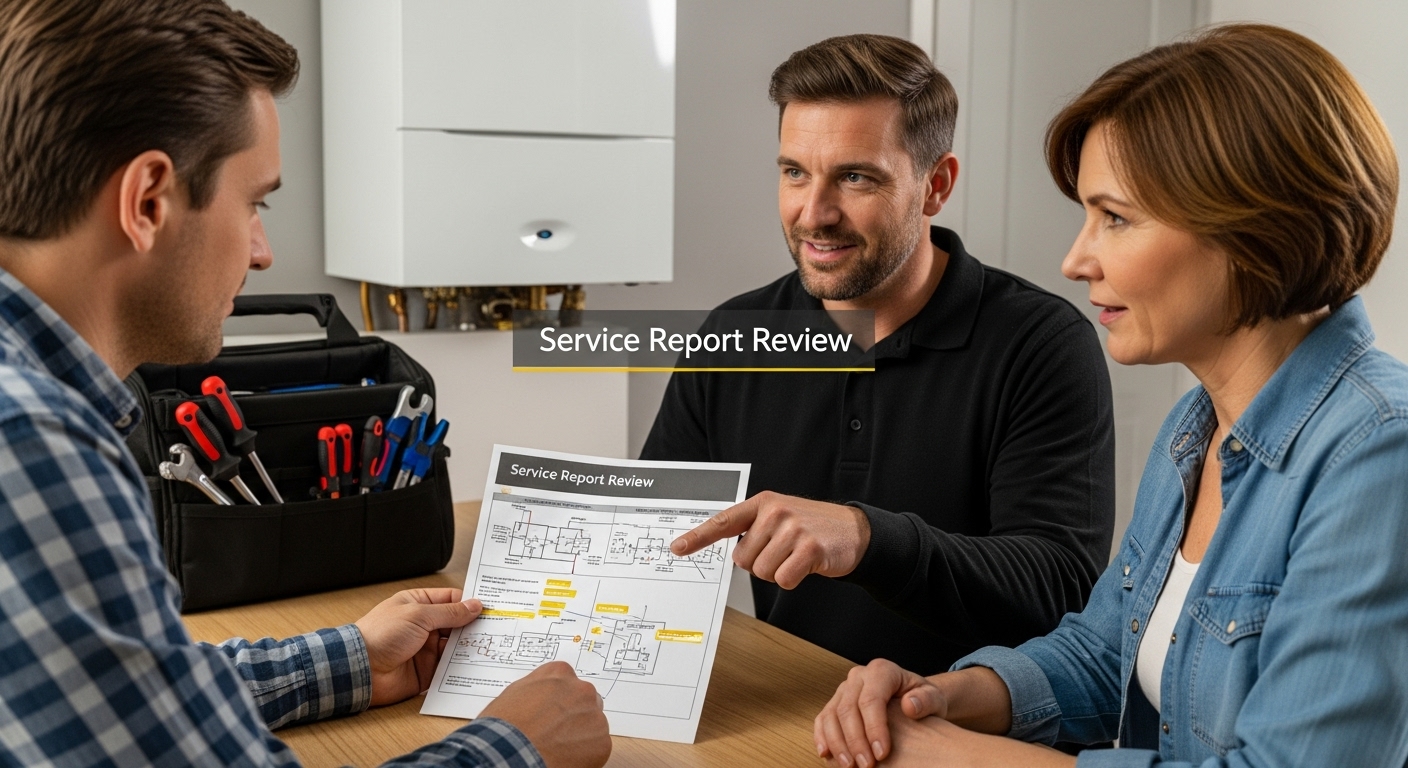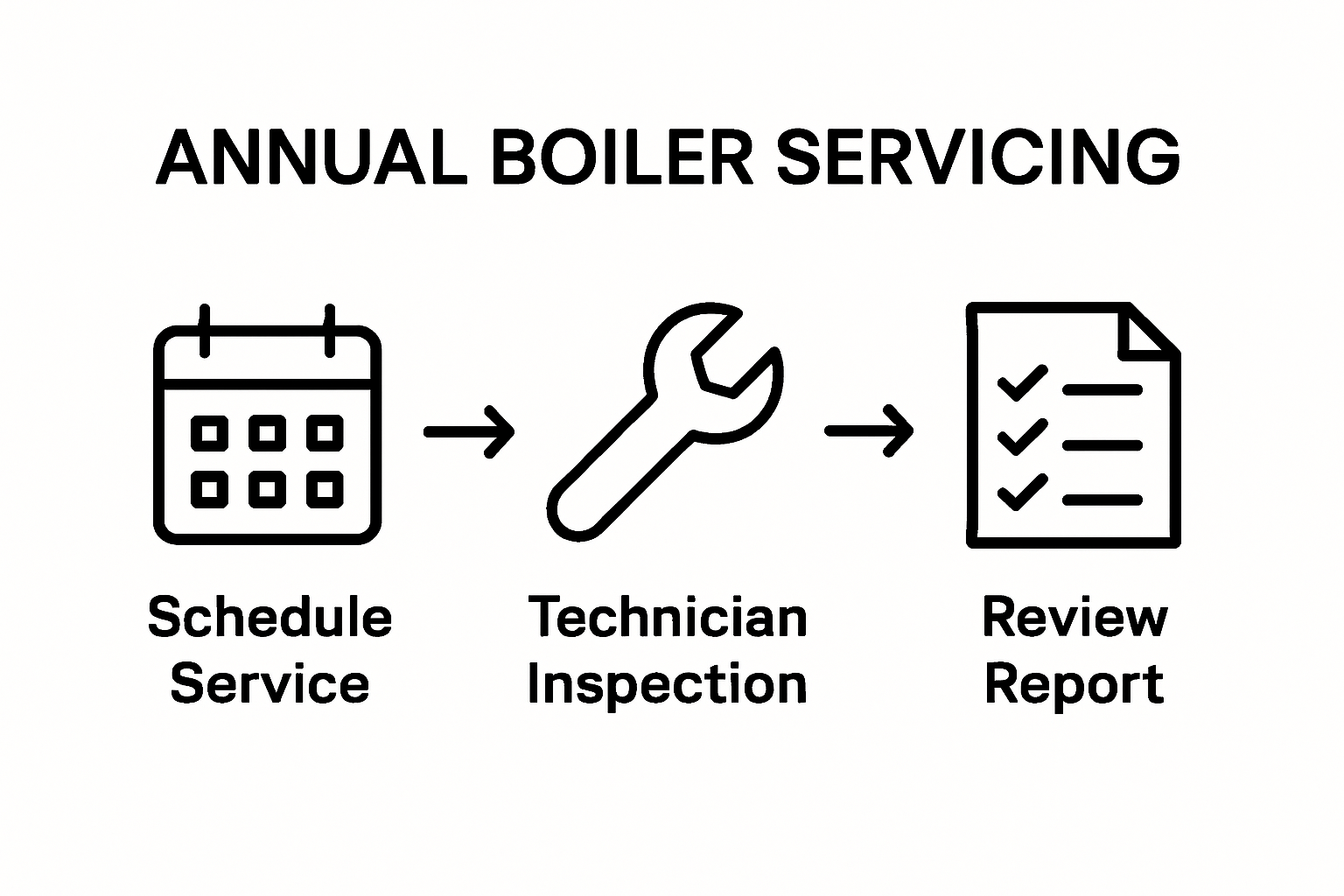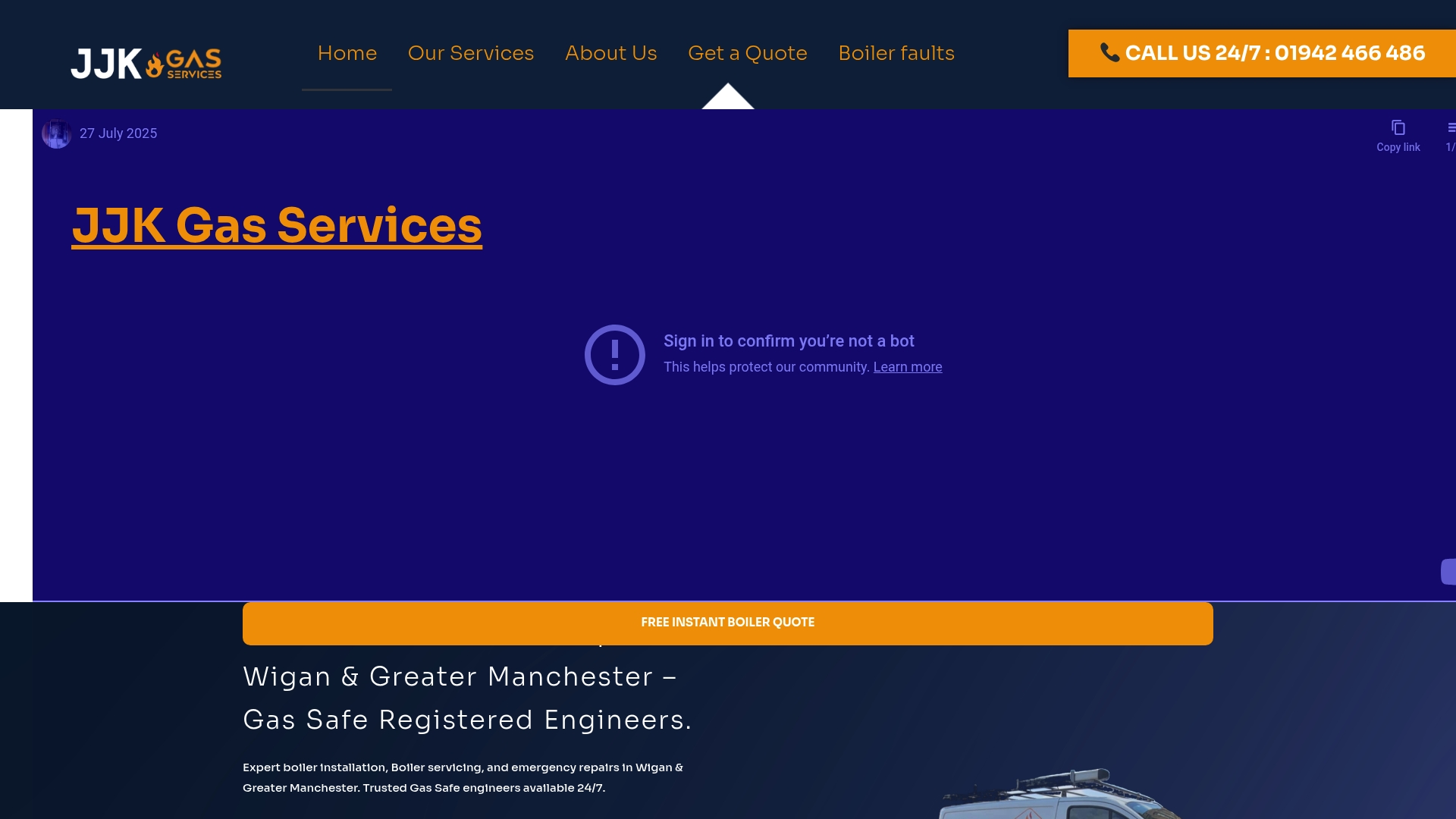Boiler servicing can seem like another chore on a long list of household tasks. Most people only think about it when the heating goes out or the cold really sets in. But surprisingly, annual boiler maintenance can reduce breakdown risks by up to 60 percent and help you avoid unexpected repair bills. What catches many off guard is how a bit of preparation and the right questions can make the entire process simpler, safer, and even save you money in the long run.
Table of Contents
- Step 1: Gather Essential Tools And Equipment
- Step 2: Schedule An Appointment With A Qualified Technician
- Step 3: Prepare Your Boiler For Service
- Step 4: Conduct The Servicing Process With The Technician
- Step 5: Review The Service Report And Recommendations
- Step 6: Maintain A Routine Servicing Schedule
Quick Summary
| Key Point | Explanation |
|---|---|
| 1. Assemble Essential Tools First | Gather tools like a multimeter, wrenches, and safety gear to facilitate a safe boiler inspection. |
| 2. Research Qualified Technicians Thoroughly | Ensure technicians are Gas Safe Registered and experienced with your specific boiler model before scheduling maintenance. |
| 3. Prepare Boiler Area for Service | Clear the space around the boiler and organize documentation to ensure the technician can perform a thorough inspection. |
| 4. Engage Actively During the Service | Ask questions and observe the technician’s work to gain insights into your boiler’s performance and necessary maintenance. |
| 5. Review Service Report Carefully | Evaluate the technician’s findings and recommendations to prioritize urgent repairs and plan for future maintenance needs. |
Step 1: Gather Essential Tools and Equipment
Preparing for a comprehensive boiler service requires assembling the right tools and equipment to ensure a thorough and safe inspection. Professional boiler maintenance demands precision, technical knowledge, and a systematic approach. Before starting any servicing work, having the correct tools will make the process smoother and more efficient.
For homeowners considering a DIY inspection or professionals preparing for a comprehensive service, you’ll need a specific set of tools and protective equipment. The fundamental toolkit should include digital multimeter, adjustable wrench, screwdriver set (with both flathead and Phillips head varieties), pipe wrench, pressure gauge, and safety glasses. These tools will help you perform detailed inspections, check electrical connections, adjust components, and measure system pressures.
Additional specialized equipment like leak detection fluid, carbon monoxide detector, and thermal imaging camera can provide more advanced diagnostic capabilities. According to ENERGY STAR’s Maintenance Checklist, having these tools allows for comprehensive system evaluation beyond basic visual inspections. Protective gear is equally crucial: wear flame-resistant gloves, safety glasses, and closed-toe shoes to prevent potential injuries during the servicing process.
Before beginning any work, create a clean, well-ventilated workspace with adequate lighting. Organize your tools systematically, ensuring everything is within easy reach. Check that all tools are in good condition, with no visible damage or wear that might compromise their functionality. Preparation is key in boiler servicing research the specific requirements of your boiler model, as different systems might need slightly varied tools or approaches.
Below is a summary table of essential tools and protective equipment needed for comprehensive boiler servicing, outlining their purpose to aid efficient and safe preparation.
| Tool/Equipment | Purpose |
|---|---|
| Digital multimeter | Check electrical connections and diagnose electrical faults |
| Adjustable wrench | Tighten or loosen boiler fittings and components |
| Screwdriver set | Remove or secure various boiler panels and screws |
| Pipe wrench | Work on stubborn pipe fittings and joints |
| Pressure gauge | Measure and verify system operating pressure |
| Safety glasses | Protect eyes during inspection and repair |
| Flame-resistant gloves | Safety against accidental burns or hot components |
| Leak detection fluid | Identify gas or water leaks in the system |
| Carbon monoxide detector | Detect dangerous carbon monoxide levels |
| Thermal imaging camera | Spot thermal anomalies and hidden faults |
Verification of your toolkit is straightforward. Ensure you have:
- All necessary tools in good working condition
- Protective safety equipment
- Manufacturer’s manual for specific model references
- Workspace prepared with good ventilation and lighting
By meticulously gathering and preparing your tools, you set the foundation for a safe, efficient, and thorough boiler servicing experience.
Step 2: Schedule an Appointment with a Qualified Technician
Scheduling a professional boiler service requires careful consideration and strategic planning to ensure your heating system receives expert attention. Selecting the right technician is crucial for maintaining your boiler’s performance, safety, and longevity. The appointment scheduling process involves more than simply picking up the phone it demands research, verification, and preparation.
Begin by researching qualified gas engineers who are Gas Safe Registered. This certification is non-negotiable and legally required for anyone working on gas appliances in the UK. Look for technicians with substantial experience specifically in boiler servicing, not just general heating maintenance. Online reviews, recommendations from friends or family, and local trade association listings can provide reliable leads. Prioritize engineers with demonstrable expertise in your specific boiler make and model.
When contacting potential service providers, prepare a comprehensive set of questions to assess their suitability. Inquire about their professional qualifications, years of experience, typical service duration, and pricing structure. According to City of Seattle’s Licensing Requirements, professional certification demonstrates a technician’s competence and commitment to safety standards. Request proof of their Gas Safe Registration number and confirm their insurance coverage before finalizing the appointment.
Consider the timing of your boiler service strategically. Late summer or early autumn are ideal periods, allowing you to address potential issues before the peak winter heating season. Most professional services recommend annual maintenance, so if it’s been more than 12 months since your last service, schedule promptly. When booking, provide detailed information about your boiler’s age, make, model, and any current performance issues to help the technician prepare effectively.
Verification checklist for scheduling your boiler service:
- Confirmed technician’s Gas Safe Registration
- Checked professional credentials and experience
- Discussed service scope and expected duration
- Obtained clear pricing information
- Scheduled at an optimal time before winter
By methodically approaching the appointment scheduling process, you set the stage for a thorough, professional boiler service that ensures your heating system’s optimal performance and safety.
Step 3: Prepare Your Boiler for Service
Preparing your boiler for professional servicing is a critical step that can significantly impact the efficiency and thoroughness of the maintenance process. Proper preparation ensures that technicians can access and evaluate your boiler system comprehensively, minimizing potential delays or complications during the service appointment.
Start by clearing the area around your boiler, creating a minimum of one metre of clear workspace on all sides. Remove any stored items, cleaning supplies, or household objects that might obstruct the technician’s access. Pay special attention to electrical equipment, cardboard boxes, or flammable materials that could pose a safety risk or impede the service process. If your boiler is located in a cluttered area like a basement or utility cupboard, take time to organize and create a clean, accessible environment.
Documentation preparation is equally important. Gather all relevant paperwork related to your boiler, including the original installation certificate, previous service records, and manufacturer’s manual. Learn more about our comprehensive Wigan boiler services which can help you understand the specific documentation requirements. These documents provide crucial information about your boiler’s history, previous maintenance, and specific technical specifications that can assist the technician in performing a more targeted service.
Before the technician arrives, conduct a preliminary assessment of your boiler’s current performance. Note any unusual sounds, temperature fluctuations, or visible issues like water leaks or pilot light irregularities. Create a written summary of these observations to share with the service professional. This proactive approach helps technicians focus their inspection on potential problem areas and provides context for any ongoing performance concerns. Additionally, ensure that all access points are unlocked and that you or another responsible adult will be present during the service to answer any questions and provide necessary information.
Verification checklist for boiler service preparation:
- Area around boiler completely cleared
- All relevant documentation collected
- Performance issues documented
- Clear access to boiler and surrounding areas
- Contact person available during service appointment
By meticulously preparing your boiler and workspace, you set the stage for a thorough, efficient, and productive service experience that can help maintain your heating system’s long-term performance and reliability.
Step 4: Conduct the Servicing Process with the Technician
The boiler servicing process is a critical moment where professional expertise meets your home’s heating system. Active participation and understanding during the technician’s inspection can provide valuable insights into your boiler’s health and performance. While the technician handles the technical aspects, your role is to observe, ask questions, and learn about your heating system’s condition.
As the technician begins the service, they will systematically examine various components of your boiler. Expect a comprehensive inspection that includes checking electrical connections, examining combustion efficiency, testing safety mechanisms, and assessing overall system performance. They will likely start by reviewing the documentation you prepared, cross-referencing it with the physical condition of the boiler. Pay close attention to their methodical approach identifying potential wear and tear, checking for any signs of corrosion, and testing critical safety features like pressure relief valves and temperature controls.
According to the U.S. Department of Energy’s maintenance guidelines, a thorough boiler service involves multiple diagnostic steps. The technician will likely perform visual inspections, measure combustion efficiency, clean critical components, and check for any potential gas leaks or carbon monoxide risks. Do not hesitate to ask questions during the process. Knowledgeable technicians appreciate homeowners who are engaged and interested in understanding their heating system. Request explanations about any findings, potential concerns, or recommended future maintenance.
During the service, the technician will generate a detailed service report. This document is crucial as it provides a comprehensive overview of your boiler’s current condition, any repairs performed, and recommendations for future maintenance. Request a copy of this report and discuss any significant findings or suggested improvements. Some technicians might recommend additional repairs or highlight components that will need attention in the near future.
Verification checklist for boiler service completion:
- Technician completed full system inspection
- Received and reviewed service report
- Understood any recommended repairs or maintenance
- Clarified any questions about boiler performance
- Obtained contact information for follow-up inquiries
By actively engaging in the servicing process, you transform a routine maintenance task into an opportunity to understand and protect your home’s heating infrastructure.
Step 5: Review the Service Report and Recommendations
The service report represents the culmination of your boiler maintenance journey, providing a comprehensive snapshot of your heating system’s current condition and future needs. Understanding and acting on this document is crucial for maintaining your boiler’s long-term performance and preventing potential future issues. This step transforms technical information into actionable insights that can protect your home’s heating infrastructure.
Carefully review the service report, paying close attention to the detailed findings. Professional technicians typically provide a comprehensive document that breaks down the inspection results, highlighting both immediate concerns and potential future maintenance requirements. Look for sections detailing the condition of critical components like the heat exchanger, combustion chamber, flue system, and safety mechanisms. The report should outline any repairs performed during the service, as well as recommendations for future maintenance or potential component replacements.
According to the U.S. Department of Energy’s maintenance guidelines, homeowners should critically evaluate recommendations for system efficiency and safety. Prioritize any suggested repairs or replacements that directly impact your boiler’s performance or safety. Some recommendations might involve minor adjustments, while others could indicate more significant maintenance needs. If the report suggests potential future issues, consider scheduling preventative maintenance to address these concerns before they escalate into more expensive repairs.
Financial planning is an essential aspect of reviewing the service report. Create a budget for any recommended repairs or potential future maintenance. Discuss the report’s findings with the technician if anything is unclear, asking for detailed explanations about the urgency and potential implications of the recommended work. Some repairs might be optional, while others could be critical for your boiler’s safe and efficient operation. Consider obtaining quotes for suggested repairs and compare them with the potential cost of future breakdown or inefficiency.
Verification checklist for service report review:
- Thoroughly read entire service report
- Understand all technical findings and recommendations
- Identify urgent and non-urgent maintenance needs
- Create a budget for potential repairs
- Schedule follow-up work if necessary
By meticulously reviewing the service report, you transform a routine maintenance document into a strategic tool for protecting your home’s heating system and managing potential future expenses.

Step 6: Maintain a Routine Servicing Schedule
Establishing a consistent boiler servicing schedule is the cornerstone of long-term heating system reliability and performance. Proactive maintenance prevents unexpected breakdowns, reduces costly repairs, and ensures your boiler operates at peak efficiency. Think of this routine as a health check-up for your home’s heating infrastructure a strategic approach that protects your investment and provides peace of mind.
Most manufacturers and heating professionals recommend annual servicing, typically during late summer or early autumn before the intense winter heating season begins. Create a dedicated maintenance calendar that tracks your boiler’s service history, upcoming appointments, and potential future maintenance needs. This systematic approach helps you stay ahead of potential issues and maintains your boiler’s warranty requirements. Modern digital tools like smartphone apps or digital calendars can help you set reminders and track service intervals effectively.
Developing a relationship with a reliable, Gas Safe Registered engineer is crucial for maintaining a consistent servicing schedule. Learn more about our comprehensive boiler maintenance services and how we can help you keep your heating system in top condition. Choose a technician or service provider who can offer continuity, understands your specific boiler model, and maintains detailed service records. This consistency allows for more accurate tracking of your boiler’s performance over time and helps identify potential long-term trends or emerging issues.
Beyond professional servicing, implement a basic monthly self-inspection routine. Check for unusual noises, monitor system pressure, inspect visible pipework for leaks, and ensure your boiler’s area remains clean and unobstructed. While these checks cannot replace professional servicing, they help you catch potential problems early and provide valuable information during your annual professional service. Keep a log of your observations to share with your technician during the next scheduled maintenance.
Verification checklist for maintaining a routine servicing schedule:
- Schedule annual professional boiler service
- Create a digital maintenance calendar
- Develop ongoing relationship with Gas Safe engineer
- Perform monthly self-inspection checks

- Maintain detailed service and inspection records
By committing to a structured, proactive approach to boiler maintenance, you transform routine servicing from a periodic task into a strategic system for protecting your home’s heating infrastructure.
The following table organises the recommended routine boiler maintenance tasks, indicating the suggested frequency and the main reason for each check. This assists homeowners in maintaining an effective long-term servicing schedule.
| Task | Recommended Frequency | Main Reason |
|---|---|---|
| Schedule professional boiler service | Annually (late summer/autumn) | Ensure optimal performance and maintain warranty |
| Create maintenance calendar | Once, then update as needed | Track service dates and plan future maintenance |
| Build relationship with technician | Ongoing | Ensure continuity and expert knowledge |
| Perform self-inspection | Monthly | Detect minor issues and maintain boiler area |
| Keep service records | After each service/inspection | Maintain compliance and monitor system history |
Experience Stress-Free Boiler Service with Trusted Local Experts
Have you found yourself worrying about unexpected boiler breakdowns or costly repairs due to missed servicing? The “Essential Guide to Boiler Servicing for Homeowners” highlights just how important regular maintenance is for safety, efficiency, and peace of mind. Yet, many homeowners struggle with finding a reliable Gas Safe engineer or feel overwhelmed by the steps involved in proper servicing and ongoing care.

Make your boiler care simple and secure by choosing a trusted provider with over 17 years of local experience. At JJ Kelly Gas Services, we offer expert boiler servicing, transparent pricing, and fast response times throughout Wigan and Greater Manchester. Whether you are looking for routine maintenance, emergency repairs or even flexible payment options, our Gas Safe Registered team ensures your home stays warm, safe, and energy-efficient year-round. Book your service online today with free instant quotes and experience the confidence that comes from relying on genuine specialists. Protect your home’s heating system now before the winter rush sets in.
Frequently Asked Questions
What tools do I need for boiler servicing?
To service a boiler, you will need essential tools such as a digital multimeter, adjustable wrench, screwdriver set, pipe wrench, pressure gauge, and safety glasses. Additional equipment like leak detection fluid, a carbon monoxide detector, and a thermal imaging camera can enhance diagnostic capabilities.
How often should I schedule a professional boiler service?
It is recommended to schedule a professional boiler service annually, ideally during late summer or early autumn, to ensure optimal performance before the winter heating season begins.
What should I do to prepare my boiler for service?
Prepare your boiler for servicing by clearing the area around it, removing any obstructions, gathering relevant documents like the installation certificate and past service records, and documenting any performance issues you’ve noticed.
What can I expect during the boiler servicing process?
During boiler servicing, the technician will conduct a comprehensive inspection, checking electrical connections, combustion efficiency, safety mechanisms, and overall system performance. It’s important to ask questions and understand their findings for better maintenance in the future.


